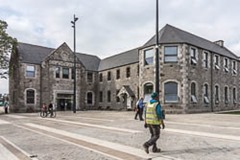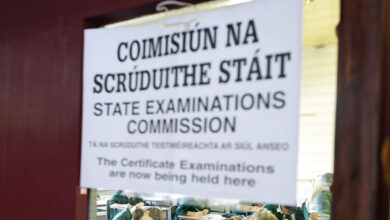Technological university plans make progress
 Institutes of technology will be able to offer more to students as technological universities under a Bill to come forward in the new year. Michael McKernan examines the plans.
Institutes of technology will be able to offer more to students as technological universities under a Bill to come forward in the new year. Michael McKernan examines the plans.
A new class of technological university is on the way, assuming current government proposals eventually reach the statute book. In January 2014, the then Education Minister, Ruairí Quinn, introduced the general scheme of the Technological Universities Bill which set out the Government’s legislative approach to closing and/or merging the existing institutes of technology and converting them into technological universities.
The new universities, with greater critical mass, would seek to upgrade and enhance their educational offering, in both teaching and research, above that of the institutions they were replacing. However, they would be different from other existing universities in that they would retain the same institute of technology practical industry focus and emphasis on outputting skilled personnel into the labour force. The proposed change effectively implements key recommendations of the National Strategy for Higher Education to 2030 (better known as the Hunt report) and the landscape report produced by the Higher Education Authority (HEA).
In announcing the general scheme of the Bill, Minister Quinn said that it represented “an essential milestone in the modernisation and reform agenda for higher education institutions.” He added: “Through mergers, they can achieve the critical mass to allow them to reach the scale and level of performance required to compete on the world stage with other similar institutions.”
Although the Government’s proposals set out a clear direction of travel, the actual requirement to merge and later apply to be part of a multi-site technological institute is to operate on a voluntary basis only. Some institutes may choose to continue in operation on a standalone basis although there is a stipulation that in such circumstances they must participate fully in regional and thematic institutional clusters.
To make the transition from ‘institute’ to ‘university’, the newly merged institutes will have to apply to the HEA. If their expression of interest is accepted, they must then prepare a detailed plan to meet the criteria for designation as a technological university and this plan will be fully evaluated by an expert panel.
The evaluation is then passed to the HEA which in turn makes an appropriate recommendation to the Minister. The Minister takes the final decision on designation.
 The general scheme for the Bill provides for the Minister to draw up regulations setting out the criteria which merged institutes must meet in order to be considered for technological university status. The proposed criteria include:
The general scheme for the Bill provides for the Minister to draw up regulations setting out the criteria which merged institutes must meet in order to be considered for technological university status. The proposed criteria include:
• provision of programmes at all levels as set out in the National Framework of Qualifications;
• provision of a minimum percentage of students at honours degree level, alongside provision for mature students, flexible learning programmes, and professional and industry-based programmes;
• the current quality of educational provision and capacity of existing staff;
• a high quality programme of research which demonstrably impacts positively in the particular region which the merged institute serves;
• capacity for doctoral training and support programmes in at least three subject areas;
• a high ongoing level of engagement with business enterprises and professional bodies;
• plans and programmes for international activity and collaboration; and
• high standards of governance and management, appropriate to a university.
The general scheme makes specific provision for the creation of a Dublin technological university based on the merger of Dublin Institute of Technology, Institute of Technology, Tallaght, and Blanchardstown Institute of Technology. Although Dublin is somewhat ahead of other regions it is expected that mergers will create other regional clusters including the institutes of technology at Cork, Tralee, Waterford and Carlow. Institutes of technology in Connaught-Ulster are also expected to set about the process of merging. This could involve the colleges in Galway-Mayo, Sligo and Letterkenny.
In addition to setting out the process for transition from institute to university, the Government’s proposals cover provision for new, stronger governing bodies, the future expansion potential of technological universities, the transfer of staff to the new universities, and the establishment of an appropriate system of oversight, performance measurement and inspection.
Scrutiny
The general scheme was submitted to the Oireachtas Joint Committee on Education and Social Protection for pre-legislative scrutiny in January. After taking evidence from a wide range of stakeholders, including various institutes, trades unions, Enterprise Ireland and IBEC, the committee published its report on 17 April.
Although the Committee made 11 basic recommendations in total, none were fundamentally at variance with the Government’s overall proposals. In fact the committee Chair, Labour TD Joanna Tuffy, acknowledged that the fundamental purpose of the Bill was to “provide education and research that is high quality and industry-focused”.
The joint committee report recommendations included:
• ensuring that the governing bodies of the new technological universities included an elected member of each of the local authorities in the principal catchment area of the university;
• a phased replacement of governing bodies to minimise disruption and to preserve corporate memory in the formation of the new universities;
• student representatives on governing bodies to be drawn from existing student unions where they existed;
• more attention to be paid to the various concerns of the trade unions in relation to terms and conditions of employment for staff transferring over to the new universities; and
• greater transparency around the whole process for designating technological universities.
Tuffy said that the formal pre-legislative scrutiny process “has resulted in what we believe is a balanced report incorporating the views of a wide range of stakeholders.” The hearings with stakeholders “highlighted the opportunities presented by the proposed legislation, as well as some of the challenges in transforming this hugely significant component of our third level system.”
The joint committee’s report on the general scheme is now on the desk of the current Labour Minister for Education, Jan O’Sullivan, who is considering its recommendations. It is likely that the draft Technological Universities Bill will be introduced to the Oireachtas sometime early in 2015.
In the meantime, it can be expected that the various institutes of technology around the country will be involved in ever more intensive discussions over plans for future mergers and amalgamations. As well as merging, they will also be working hard on building overall capacity with a view to meeting the essential criteria for successful transition to technological university status.





